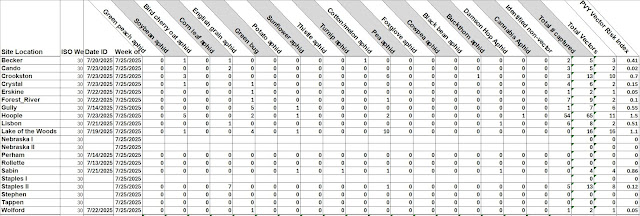Trap Catches to July 25, 2025.
With 17 traps reporting this week the number of aphids recovered in traps this week were approximately the same as last week. However, the PVY Vector Risk Index increase was not as large (reflecting a greater proportion of less efficient vector species in the catch this week - see our section on the PVY Vector Risk Index below). Recent rain events in various parts of the region may also have suppressed aphid flights.
Soybean aphid numbers are up this week, perhaps signaling the onset of what Bruce Potter (an outstanding IPM researcher) coined as The Sturgis Dispersal Event. We frequently experience a wide scale dispersal flight of soybean aphids within a couple of weeks of the start of the Sturgis motorcycle rally. Cotton melon aphid numbers were up this week, and both small grain aphids and potato aphids remain active.
The drier, but still warm, weather expected next week may increase aphid flights. As small grains continue to dry and harvest increases, look for increased numbers of small grain aphids moving to alternate crops to finish their season. We tend to have our biggest aphid flights in early August, and while this week's capture was behind the 13 year average, our PVY Vector Risk Index values remain on that average track.
So, keep scouting and checking the predictive sites!
PVY Vector Risk Index - The ability of an aphid to transmit a virus is referred to as its vector efficiency, these values can be compared across species as a relative efficiency factor (REF). Because data indicate it is the most efficient aphid species in transmitting PVY, green peach aphid's REF is set as 1, with other species' REF being calculated on their comparison to green peach aphid. E.g. soybean aphid has been found to be approximately 10% as efficient at transmitting PVY as is green peach aphid, so soybean aphid is assigned a REF of 0.1. The PVY Vector Risk Index is a reflection of the comparative ability of the different aphid species to transmit PVY to plants. By multiplying the number of a species caught by its REF, we can estimate the risk from the total vectors captured, adjusted by the ability to transmit virus.
- the research literature reports that the use of crop oils is the most consistent post-planting technique in preventing transmission of PVY and it can be improved with the addition of the insecticide Lambda-Cyhalothrin.
- most of the research indicates that insecticides on their own are usually not effective enough at suppressing PVY transmission, but are still very useful parts of your management program. Treating fields with one of the anti-feeding insecticides (e.g. Sivanto Prime, Sefina, Transform, Fulfill or Beleaf) to control colonizing aphids, such as green peach, potato, or cotton melon aphids, can be beneficial in decreasing movement of PVY inoculum within fields
- aphids preferentially first colonize fields at the edge. Using border crops in the headlands may decrease aphid colonization. But if using a border crop, it's a good idea to use treated seed to prevent the development of potential vector species in that border. Also, include those border crops when treating the field for colonizing aphids!
Happy scouting and have a great weekend!
Click on any image below for larger-scale version.





